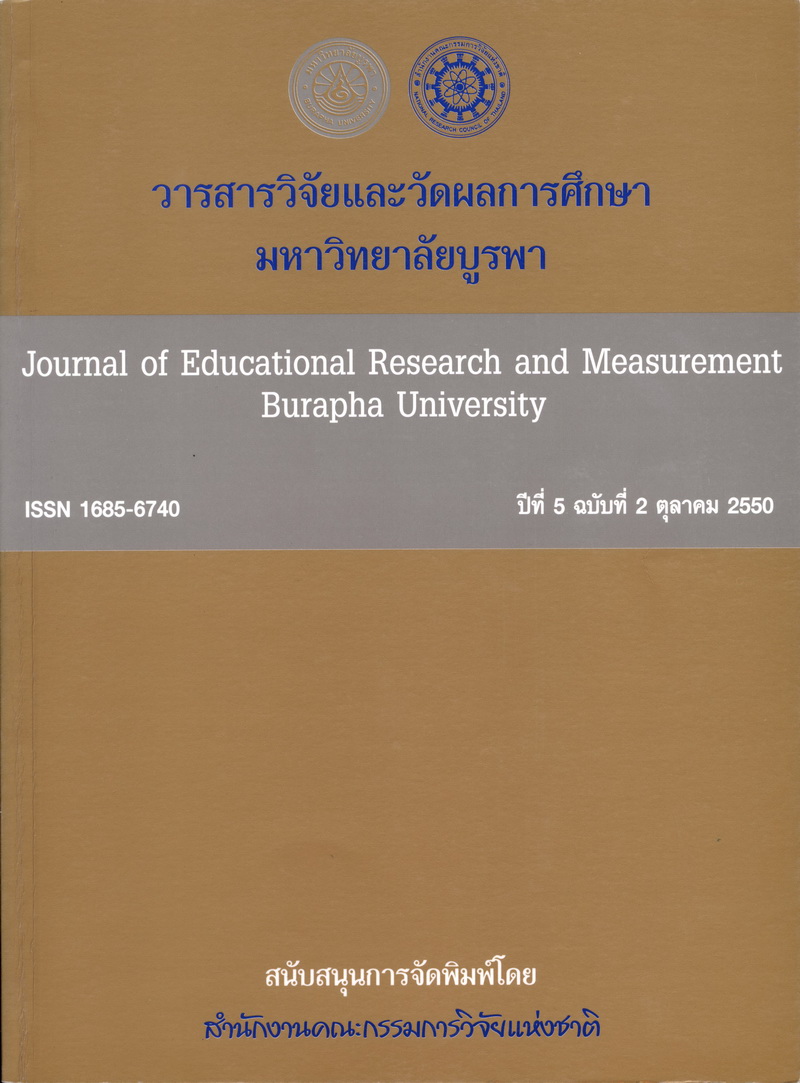การพัฒนาวิธีการทดสอบการแจกแจงปกติพหุตัวแปรแบบใหม่ โดยการปรับปรุงวิธีการทดสอบของเฮนซ์ - เซอร์เคลอร์
Main Article Content
Abstract
การวิจัยนี้มีวัตถุประสงค์เพื่อพัฒนาและตรวจสอบคุณภาพของวิธีการทดสอบการแจกแจงปกติพหุตัวแปร
แบบใหม่ โดยการเพิ่มพารามิเตอร์ทำให้เรียบเข้าไปในวิธีการทดสอบของเฮนซ์-เซอร์เคลอร์ ซึ่งเป็นฟังก์ชั่นของ ค่าคาดหวังความเบ้และความโด่งพหุตัวแปร การเปรียบเทียบอัตราความคลาดเคลื่อนประเภทที่ I และอำนาจการทดสอบของวิธีการทดสอบที่พัฒนาขึ้นใหม่กับวิธีการทดสอบการแจกแจงพหุตัวแปรแบบอื่นอีก 4 วิธี ภายใต้เงื่อนไขที่หลากหลาย โดยใช้วิธีการจำลองสถานการณ์แบบมอนติ คาร์โล จำลองข้อมูล 50,000 ชุดจากการแจกแจงพหุตัวแปร 5 แบบที่มีค่าความเบ้และความโด่ง ขนาดกลุ่มตัวอย่าง และจำนวนตัวแปร แตกต่างกัน วิธีการทดสอบที่พัฒนาขึ้นใหม่มีอัตราความคลาดเคลื่อนประเภทที่ I (ที่ระดับ .05 และ .01) ตํ่ากว่าวิธีการทดสอบความเบ้พหุตัวแปรของมาร์เดีย และวิธีการทดสอบของเฮนซ์-เซอร์เคลอร์ ส่วนวิธีการทดสอบความโด่งพหุตัวแปรของมาร์เดียและวิธีการทดสอบของรอยสตันไม่สามารถควบคุมอัตราความคลาดเคลื่อนประเภทที่ I ได้ วิธีการทดสอบที่พัฒนาขึ้นใหม่มีอำนาจการทดสอบสูงสำหรับการแจกแจงแบบทีพหุตัวแปรและการ แจกแจงไค-สแควร์พหุตัวแปร แต่มีอำนาจการทดสอบตํ่าในการแจกแจงผสมปกติ เช่นเดียวกับวิธีการทดสอบ วามเบ้พหุตัวแปรของมาร์เดีย และวิธีการทดสอบของเฮนซ์-เซอร์เคลอร์ วิธีการทดสอบที่พัฒนาขึ้นใหม่ มีอำนาจการทดสอบสูงกว่าวิธีการทดสอบของเฮนซ์-เซอร์เคลอร์ในการแจกแจงแบบทีพหุตัวแปรและการแจกแจงไค-สแควร์พหุตัวแปร แต่มีอำนาจการทดสอบตํ่ากว่าวิธีการทดสอบของเฮนซ์-เซอร์เคลอร์ในการแจกแจงแบบผสมปกติ
Developing a New Multivariate Normality Test by Improving on the Henze-Zirkler Method
The objective of this study was to develop and evaluate a new multivariate normality test created by adding a smoothing parameter to the Henze-Zirkler test, with the parameter based on expected values of multivariate skewness and kurtosis. The new test’s Type I error rate and power were compared to figures from four other tests of multivariate normality under a variety of conditions. Monte Carlo procedures were used to generate 50,000 data sets from six multivariate distributions having different skewness and kurtosis values, sample sizes, and number of variables. Type I error rates of the new test (at .05 and .01) were lower than those from Mardia’s measure of skewness and the Henze-Zirkler test. It was found that Mardia’s measure of kurtosis and Royston’s test had unacceptably high Type I error rates. The power of the new test was found to be high for the multivariate t and chi-square distributions, but low in the case of normal mixture distributions, as was also the case with Mardia’s measure of skewness and the Henze-Zirkler test. The new test’s power was better than Henze-Zirkler’s with multivariate t and chisquare, but lower than Henze-Zirkler against normal mixture distributions.

